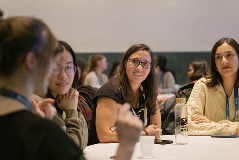E.coli evolved to eat CO2
Feb 13, 2020|Season 2, Episode 3
Sophia Chen of MRS Bulletin interviews Ron Milo of the Weizmann Institute of Science in Israel about a strain of E. coli his team developed that generates all its biomass from carbon dioxide. Their work was achieved through a technique called adaptive laboratory evolution, that is, evolutionary selection. Read the article in Cell.
SOPHIA CHEN: Inside a lab at the Weizmann Institute of Science in Israel, biologist Ron Milo and his team have engineered a strain of E.coli with an unusual diet. Natural E.coli is a heterotroph, meaning that it can only consume organic carbon compounds—like glucose. But Milo’s team converted the bacteria into an autotroph, an organism such as a plant that can consume inorganic carbon. They essentially changed the bacteria’s metabolic process.
RON MILO: What we did in this study is show that we could take an organism of the second type, a heterotroph, in this case E.coli, that is used to having its diet coming from glucose in the media, and being able to transform it into the first type, the autotrophs, which build all their biomass directly from CO2.
SC: To do this, Milo’s team had to enable E.coli to perform carbon fixation. Carbon fixation is a capability found in plants where inorganic forms of carbon are converted into organic compounds. This process involves first by adding electrons to the inorganic carbon, or reducing it, which allows the carbon to form an organic molecule. Then, the organic carbon is converted into biomass such as proteins and carbohydrates inside the cell. They did this by adding some genes into the bacteria’s DNA. One gene, for example, enabled the E.coli to reduce the carbon by taking electrons from a compound called formate. They also put in other genes.
RM: So we put in the gene that takes carbon dioxide and incorporates it into biomass. It’s a gene called rubisco. We also put in a gene that builds a substrate for rubisco, it’s called PRK.
SC: The engineered bacteria still ate sugar, so to make bacteria that ate only CO2, they turned to a technique known as adaptive laboratory evolution. They placed the engineered bacteria in a container with very little sugar and a high concentration of CO2, an environment which basically starved the cells. In this low sugar environment, they let the bacteria reproduce several hundred times for nearly a year. Eventually, they found that these later generations of E.coli generated all their biomass from CO2.
RM: The process of carbon fixation aims to find ways to deal with the challenge of how do you produce transportation fuels that will not harm the environment as well as how to increase the yields in agriculture, and more generally, to see if there’s ways to sequester CO2 from all sorts of concentrated sources or even directly from the air.
SC: The bacteria produced CO2 in addition to consuming it. In total, it created a net gain of CO2. So in its current form, the bacteria would not be useful for many applications. But they’ve come a long way since Milo started the project about a decade ago.
RM: I remember when I presented this work, people thought it was somewhere between naive and crazy to think that one could actually change a heterotroph into an autotroph. We did most of our experiments in an atmosphere of 10% CO2. We could also show we could grow bacteria in lower CO2 levels of say, about 1 percent. But what we have in the atmosphere around us is about 400 parts per million, and we want to see if we can evolve the bacteria to grow in that.
SC: Thank you for listening.

